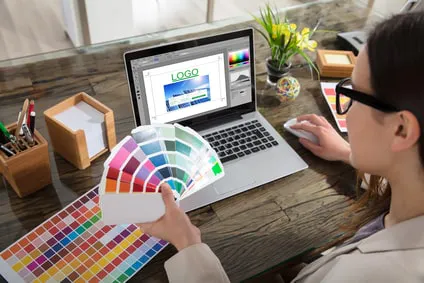Building a business isn’t easy.
When you start out, you’re probably doing everything on a shoestring budget … and logo design might be far from the top of your list of priorities.
You probably haven’t allocated funds to it, perhaps hoping you can just handle it yourself. If you do hunt around for a proper designer, you might find the cost seems pretty high for a simple graphic or even a word written in an interesting font.
But your logo is a crucial part of your brand … not an afterthought. Here’s why it matters.
Why your logo is so vital

Your logo should be instantly recognizable, and it should match your customers’ expectations. (For instance, if your company provides retirement planning services, you’re unlikely to want a hot pink logo in a loopy handwriting font.)
Your logo can:
- Make customers more aware of who you are. It should be easy to pick out… meaning that customers will start to gain a sense of familiarity with your logo (and hence with your company).
- Reflect the essence of your company. You might have a bold, fun logo, for instance, that communicates your laid-back style, or you might have an ornate, even slightly old-fashioned, logo that emphasizes your years of experience in your field.
- Brand your products or packaging. Think of the bitten Apple logo on Apple’s products, for instance, or the Nike swoosh on trainers: they’re highly recognizable (and, in fact, the presence of the branding makes these products more valuable).
A logo is essential for most businesses. You’ll want to use it in all sorts of ways – on your website, on social media accounts, in advertising, and in publications like newsletters and brochures.
Four different ways to create a logo

There are several different logo styles out there: some are purely textual, but many will combine text and a symbol (and some are symbols without any text at all).
Whatever type of logo you’re going for, though, it should be:
- Simple – your logo shouldn’t use five different colors or four different fonts (with rare exceptions)
- Memorable – it shouldn’t be too bland, and should be easily distinguishable from your competitors’ logos
- Scalable – it should work equally well as a tiny thumbnail and as a large printed logo
When it comes to creating the logo, you’ve got a few different options:
#1: Taking the DIY route
This is the route that quite a few companies opt for, especially if they’re on a tiny budget: they use some sort of graphics tool (possibly a free one, like Paint.NET) to create their own logo.
Pros:
- You don’t need to spend any money to create your own logo.
- You have full creative control: you can make whatever logo you like, without needing to explain your ideas to a designer.
Cons:
- Unless you’re an experienced designer, your logo is almost certainly not going to end up being of professional quality (and this can have a negative impact on how seriously people see your business).
- You might end up spending a lot of time trying to get your logo right – at the expense of other business tasks you need to do.
#2: Paying a designer
There are plenty of logo designers out there – and many of them are very good at their work. You could ask other business owners who created their logo or look at samples on designers’ websites to get a sense of their skills.
Pros:
- You’ll get a professional result: not just a logo that looks good, but one that’s provided in appropriate file formats.
- You don’t have to spend much time on the logo creation process yourself (apart from explaining what you want to the designer).
Cons:
- You may find that the finished logo isn’t really what you envisaged – most designers do go back and forth with you during the design process, though, so hopefully you will end up happy with the end result.
- It can cost a lot to get a logo designed, and you may find it difficult to come up with the money at an early stage of your business.
#3: Crowdsourcing your logo
There are quite a few sites out there, like 99 Designs and Crowdspring, where you can put out a request for a logo and get lots of options from different designers in response. You then gradually whittle these down to a design you want.
Pros:
- You can get plenty of options – and you’ll likely find that some designers come up with ideas you’d never have thought of.
- It might work out cheaper than selecting and paying a single designer directly.
Cons:
- The
quality of the finished logos may not be as high as if you’d gone with a
regular designer. - You’ll
have to do quite a bit of admin work reviewing and rating the submitted designs
– some of which may be seriously sub-par.
#4: Using an online logo template or generator
Finally, you could use an online logo template (Canva has quite a few free ones available) or a logo generator such as ZenBusiness or Brand Crowd to come up with your logo.
Pros:
- This
is likely to be a lot faster than trying to design your own logo from scratch
(especially if your graphic editing skills are a bit lacking). - In
most cases, it won’t cost you anything.
Cons:
- Your
logo may end up looking rather generic, rather than unique and memorable. - You’re
not going to get the same level of quality as you’d receive from a
professional, paid designer.
There’s no one “right” way to create a logo for your business. Obviously, if you have a budget, it makes sense to hire a professional. But if not, using a template or logo generator is a good way to at least get a simple logo in place for your brand.




